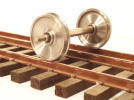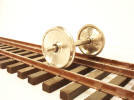|
Freight Car Trucks
(updated 1-7-14)
Several
varieties of freight car truck are now available in F Gauge.
More are in development (see below). Each truck is cast in white metal
and equipped with plain steel wheels, stainless steel axles, and
3/16" ID ball bearings.
Each truck begins as a 3D CAD drawing based upon a specific prototype, using
my own measurements, or where available, actual railroad
blueprints. My thanks in particular go to the archives of both the
Norfolk &
Western Historical Society and those of the
Southern Railway Historical Association
for generously making available scanned prototype drawings.
Wheel
Standards for F Gauge as developed by the National
Model Railroad Association (NMRA) and as used by CME may be
found here.
Trucks are sold by
the pair. Trucks come with plain steel wheels. Nickel-plated steel wheels
are available at extra cost. Please direct all truck and wheel
orders to Mr. Don Niday (
donniday@ironcreekshops.com )
or call
(865) 671-1270.
Available Trucks
(updated 1-7-14)
Truck & Wheel
Parts (updated 1-7-14)
Most freight car trucks
from the steam era rode on 33" wheelsets while modern roller
bearing equipped trucks generally use 36". Similarly most
passenger cars from both eras have ridden on 36" wheelsets. The
wheelsets pictured below were produced by Cumberland Model
Engineering for
Iron Creek Shops
and are available in either rusty, polished steel or nickel
plated finishes. Each wheelset is double insulated and uses a
stainless steel 8mm axle with 3/16" journals on the stub ends.
| |
Size & Material |
Price |
|
|
Size & Material |
Price |
 |
33" Steel, Polished |
$12.95 |
 |
36" Steel, Polished |
$12.95 |
 |
33" Nickel Plated |
$15.45 |
 |
36" Nickel Plated |
$15.45 |
|
|
Truck Springs--small
(.240 x .375) |
10¢
each |
|
Truck Springs--large
(.280 x .550) |
10¢
each |
Freight Car Trucks in
Development
(updated 1-7-14)
|
Prototypes |
Historical Information |
Status of Model |
Material |
Price
(Add for nickel plated wheels) |
30 Ton Archbar
.JPG)
(5'-0" Wheelbase) |
The prototype for this truck is a typical late 19th-early 20th
century archbar design using a pair of steel I-beams for a bolster. The
5'-0" wheelbase and 4¼ x 8 journal boxes
were very common for this era and could be found beneath multiple
varieties of wooden rolling stock. This particular truck supports a 36'
Ma & Pa wooden boxcar preserved in operable condition on
the
Strasburg Railroad located near
Lancaster, PA. |
.jpg)
Brass Casting Pattern |
White
Metal |
TBA |
30 Ton Archbar
.jpg)
(5'-2" Wheelbase) |
The Southern Railway prior to and
following World War I used 5'-2" wheelbase archbar trucks under many of
its wooden freight cars. Variations included differing varieties of cast
column, the "set" or height of the archbars above the rail head, Simplex
bolsters built up from 12" channels and bar stock, and double bolts
through some columns. The version modeled here is based upon drawings
provided by the
Southern Railway Historical Association for the SR standard
30 ton boxcar. |
.jpg)
2D CAD Drawings |
White
Metal |
TBA |
40 Ton Archbar
.jpg)
(5'-0" Wheelbase) |
With
the dawn of the steel car era, archbar trucks of greater
capacity were developed, some of which were easily able to
support loads of 50 tons or even more. This 40 ton example, with
5 x 9 journals and a cast steel bolster, was in use on the
Cass Scenic Railroad and its lumber hauling
predecessors beneath 40' wooden flat cars originally built prior
to WWI. The model is based upon my own measurements of one of
the remaining trucks made on a rainy, cool September day in
2002. |

2D CAD Drawings
& Brass Bolster |
White
Metal |
TBA |
50 Ton USRA Andrews
.JPG)
(5'-6" Wheelbase) |
As
a successor to the archbar truck, the Andrews concept of a cast
steel frame with removable journal boxes antedates the United
States Railway Administration (USRA) by nearly 20 years. The
USRA U-section 50 ton design and its clones were made in the
1000s after WWI and remained in service throughout the
WWII era, and into the modern era in work trains. The casting pattern shown
at right was cut on my wire EDM and will be joined to
miniature 5½ x 10 journal boxes w/ square
bolts. |
_small.JPG)
2D CAD Drawings
& Brass Side Frames |
White
Metal |
TBA |
40 Ton 1896 Andrews Patent
.JPG)
(5'-6½"
Wheelbase) |
_small.JPG) The
Andrews design was first patented in 1896 as a "T" rather than a
"U" section side frame; and as
such, did not have the strength
of the later U-section designs. Nevertheless, the T section was
an improvement upon the old archbar trucks, and could still be
found in the post-WWI era on small locomotive tenders, some
freight cars, and, as in the case of this truck, the Denver &
Rio Grande's standard gauge idler cars. This particular truck
supports idler car X-3050 at the
Colorado Railroad Museum in
Golden and is still used on occasion for switching on dual gauge
track. The
Andrews design was first patented in 1896 as a "T" rather than a
"U" section side frame; and as
such, did not have the strength
of the later U-section designs. Nevertheless, the T section was
an improvement upon the old archbar trucks, and could still be
found in the post-WWI era on small locomotive tenders, some
freight cars, and, as in the case of this truck, the Denver &
Rio Grande's standard gauge idler cars. This particular truck
supports idler car X-3050 at the
Colorado Railroad Museum in
Golden and is still used on occasion for switching on dual gauge
track. |
 The
F scale version is unique in that (1) this truck has never been
modeled before and (2) its casting patterns were
created from 3D CAD drawings printed as wax rapid
prototypes by Swiss modelmaker
Steve
Weber. Pictured is the new metal side frame
casting pattern. My thanks to Steve and to both Kevin Strong
& Rick Blanchard for their research help! The
F scale version is unique in that (1) this truck has never been
modeled before and (2) its casting patterns were
created from 3D CAD drawings printed as wax rapid
prototypes by Swiss modelmaker
Steve
Weber. Pictured is the new metal side frame
casting pattern. My thanks to Steve and to both Kevin Strong
& Rick Blanchard for their research help! |
White
Metal |
TBA |
Steam Locomotive Tender
Trucks in Development
(updated 1-7-14)
|
Prototypes |
Historical Information |
Status of Model |
Material |
Price
(Add for nickel plated wheels) |
1896 Andrews Patent Tender
.JPG)
(5'-10"
Wheelbase) |
Prior to the much
more common USRA Andrews trucks of the 1920s and 30s
there was the 1896 Andrews Patent truck. These
trucks have been used on a variety of tenders,
including various Southern Pacific consolidations.
The truck at left was used on the tender of Southern
Railway 2-8-0 #154. |
3D
CAD Drawing of Side Frame |
Brass |
TBA |
Floating Bolster Archbar
.jpg)
(5'-7½"
Wheelbase) |
The rigidity of
archbar trucks was greatly improved by the
substitution of one central casting in lieu of two
cast columns on each sideframe, and the provision of
two steel channels, riveted to those same castings,
spanning the width of each truck. Similar to the
Theilsen truck, the floating bolster truck
substituted a spring mounted bolster for a swinging
one. These trucks are found on the tender of
Southern Railway G class 2-8-0 #107. |
2D CAD Drawings, wire EDM cut Archbars |
Brass |
TBA |
USRA Andrews Tender
.jpg)
(5'-8"
Wheelbase) |
Although the USRA
pedestal tender truck may have been more common, at
least initially, the most common two axle freight
locomotive tender of the steam era is probably the
70 ton USRA Andrews as equipped with leaf springs
and a swing motion bolster. This truck lives beneath
SR Ks-1 2-8-0 #722. |
2D CAD Drawing in Progress |
Brass |
TBA |
Passenger Car Trucks in
Development
(updated 1-7-14)
|
Prototypes |
Historical Information |
Status of Model |
Material |
Price
(Add for nickel plated wheels) |
Pullman Palace Car 6-Wheel Truck
(with bolted-on pedestals)
.gif)
(15'
Wheelbase) |
 Passenger
car trucks were not always metal. In fact until the turn of the last
century, many passenger car trucks were still of composite wood and iron
construction, with iron pedestals, journal boxes and braces being bolted
onto a wooden frame. Such was the case with the Pullman Palace 6 wheel
trucks. The patterns for these circa 1890 trucks are based upon drawings
published in the 1892 book by William Voss Railway Car Construction. Passenger
car trucks were not always metal. In fact until the turn of the last
century, many passenger car trucks were still of composite wood and iron
construction, with iron pedestals, journal boxes and braces being bolted
onto a wooden frame. Such was the case with the Pullman Palace 6 wheel
trucks. The patterns for these circa 1890 trucks are based upon drawings
published in the 1892 book by William Voss Railway Car Construction. |
.JPG)
This model is the work of Jim McDaniel (see his
gallery here)
who has agreed to let me reproduce his masterful F scale trucks using
his casting patterns and my own laser cut basswood components. These
fully equalized swing motion trucks will be offered as kits. |
Brass Castings w/
Laser Cut Wood Frame |
TBA |
|

.jpg)





_small.jpg)


.jpg)
.jpg)
.jpg)
.jpg)
.jpg)
.jpg)
.gif)